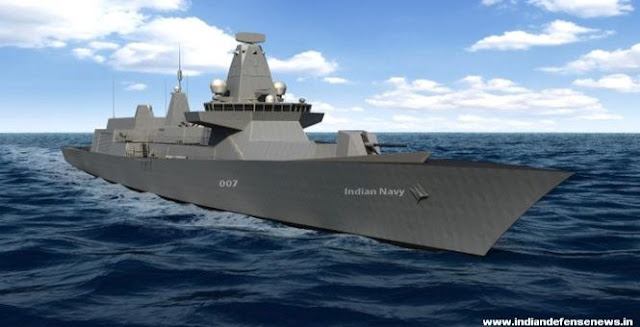
India's Futuristic Naval Stealth Frigate Design by Directorate of Naval Design - Indian Navy
In a clear expression of intent, defence minister Manohar Parrikar on Wednesday announced in Mumbai that the Narendra Modi government was “fully committed to developing a real blue-water Navy, a Navy which can dominate the Indian Ocean region”.
Speaking at a ceremony to mark the commissioning of the new state-of-the-art indigenous guided missile destroyer INS Kochi, that will further strengthen the Indian Navy’s operational capabilities, the minister was quick to add that it would be a Navy regarded as friendly by neighbouring countries. Observers noted the minister’s emphasis on Indian naval “dominance” of the Indian Ocean region was a clear signal that the Modi government was focused on building maritime strength, given the Chinese Navy’s increasing footprint and the movement of Chinese submarines in the Indian Ocean region.
The minister went on to say the Navy had drawn up an indigenisation plan for the next 15 years. “There is renewed enthusiasm in defence production units, PSUs and the private sector,” he said, also referring to a “mixed success” on the missile system technology front. “In the next five years there will be indigenisation to a large extent in missile technology,” he said. The finish of INS Kochi was as “good as any foreign (naval) ship”, he said, lauding its builders.
The defence ministry, in a statement from New Delhi, said: “Commissioning INS Kochi, the second ship of the indigenously-designed and constructed Project 15A (Kolkata-class) guided missile destroyers, Mr Parrikar gave two examples to illustrate his point — that of transporting drinking water to the Maldives when the latter’s water treatment plant was damaged last year, and the rescue and evacuation of nationals of over 20 countries from war-torn Yemen by the Indian Navy, without any damage to our platforms and personnel.” INS Kochi has been built by Mumbai’s Mazagon Dock Ltd.
“Mr Parrikar said while we have achieved significant indigenisation in the ‘Float’ component of warships, we are lacking in the indigenisation of the high-end Fight components. To that end, the government is in the process of putting a policy in place to achieve high amount of self- reliance in the defence industry under the guidance of PM Narendra Modi. The minister said the government is seized of the nation’s defence requirements and requisite financial support for the armed forces and defence industry will be made available, which includes the modernisation and development plans of the Navy. The government shall always remain committed to provide necessary funds for expansion and growth of the Navy,” the MoD said.
The commissioning ceremony was attended, among others, by Navy Chief Adm. R.K. Dhowan, who said: “Induction of INS Kochi, with her multi-dimensional combat capability, adds more teeth to the sword arm of the Indian Navy in discharging her duties of safeguarding national maritime interests. This further reaffirms our resolve and faith in indigenous shipbuilding and the ‘Make in India’ programme.”
The MoD said: “INS Kochi is the second of the Kolkata-class destroyers. It measures 164 meters in length and approximately 17 meters in width, with a full load displacement of 7,500 tonnes... INS Kochi incorporates new design concepts for stealth and has many firsts to her credit, including a very large component of indigenous combat-suite. The ship is packed with most sophisticated state-of-the-art weapons and sensors, including the vertically launched Long Range Surface to Air Missiles (LRSAM) and MF-STAR multi-function active phased array radar, which is fitted only on the Kolkata-class of ships. It is equipped with the advanced supersonic and long range BrahMos Surface to Surface Missile – a joint Indo-Russian venture. The 76 mm Super Rapid Gun Mount (SRGM) and AK 630 CIWS, both manufactured indigenously, can take on air and surface targets. The entire anti-submarine weapon and sensor suite fitted onboard, consisting of Indigenous Rocket Launchers (IRL), Indigenous Twin-tube Torpedo Launchers (ITTL) and a bow-mounted New Generation HUMSA Sonar are fine examples of India’s indigenous efforts in the field of underwater warfare. The sensor suite includes other advanced Surface to Air surveillance radars and an indigenous Electronic Warfare System. A state-of-the-art Combat Management System (CMS- 15A) has been integrated with the onboard weapons and sensors. The ship is equipped to operate two Sea King or Chetak helicopters.”